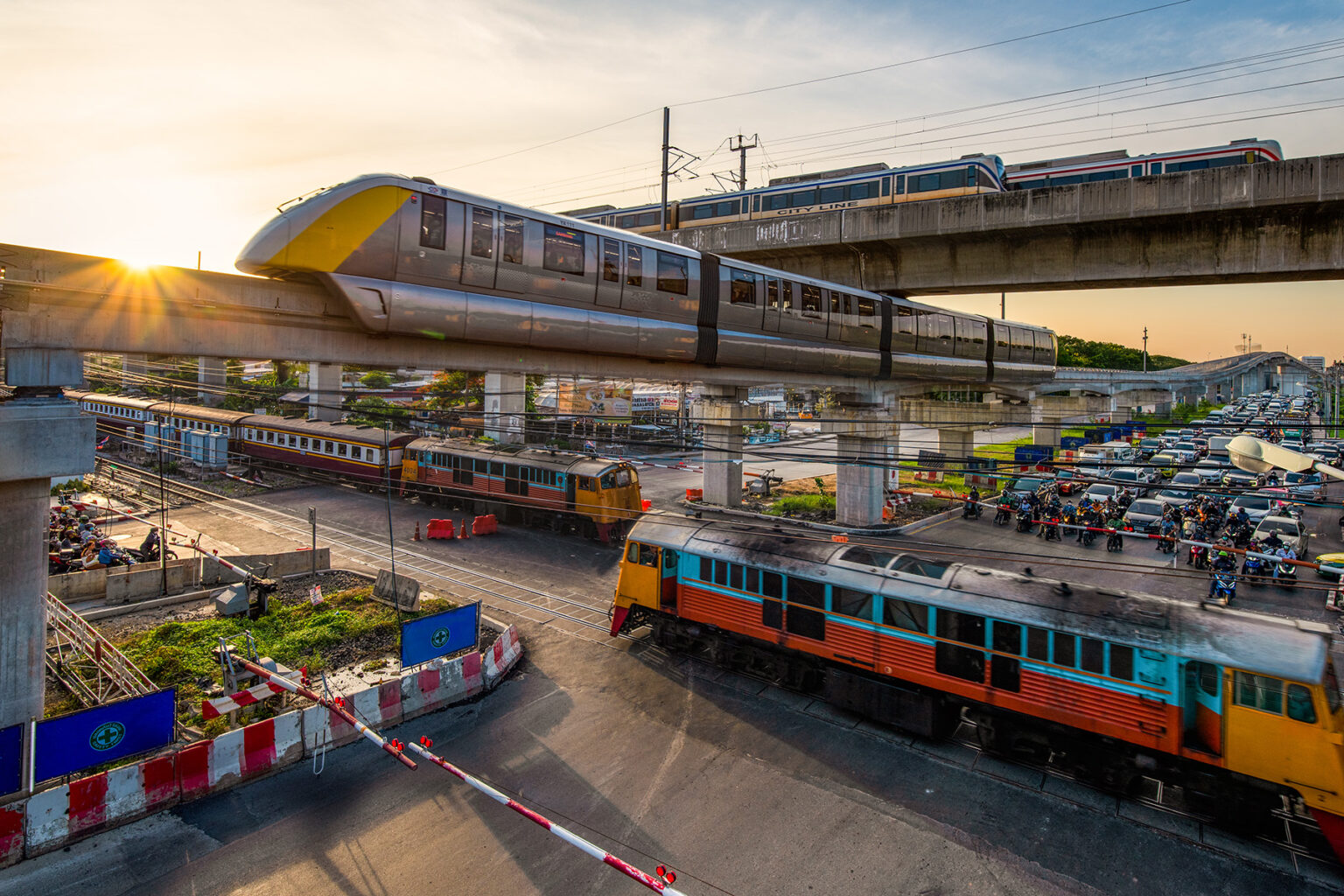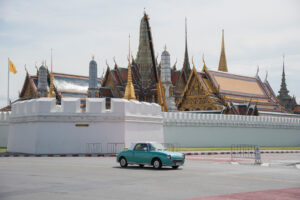New expats to Thailand (ประเทศไทย) have plenty to figure out, including a new language and culture. But understanding the ins and outs of the country’s transportation is an important step to acclimatizing to your new home. The capital of Bangkok (กรุงเทพฯ) has numerous options for getting around, while other parts of the country have slightly different offerings.
Here’s what you need to know about getting from A(yutthaya) to B(uriram) and beyond:
- Overview of public transportation in Thailand
- Public transportation apps and/or websites
- Are there trains that go through Thailand?
- Are there trains in Bangkok?
- How to get around Thailand by bus?
- What buses can you take in Bangkok?
- Taxis, UBERs, and other car services
- Long-distance bus services in Thailand
- Which airports are there in Thailand?
- Other forms of public transport in Thailand
- Are there any discounts or financial aid?
- Is Thai public transport disability-accessible?
- Is public transport environmentally friendly?
- Safety tips for transportation in Thailand
- How to file a complaint about public transport
- Useful resources
Overview of public transportation in Thailand
Many expats in Thailand have cars and even drivers to chauffeur them around. However, traffic in the country – and Bangkok in particular – is notoriously bad, so public transport can be a great way to avoid the rush-hour snarls. As such, new expats to the capital – or other Thai cities – will want to figure out how to get around quickly.
The Ministry of Transport (MOT – กระทรวงคมนาคม) oversees all aspects of public transportation in Thailand. The government spends some THB173.2 billion a year to keep public transport (ขนส่งสาธารณะ) services going across the country, so there are plenty of easy, cheap ways to get around.
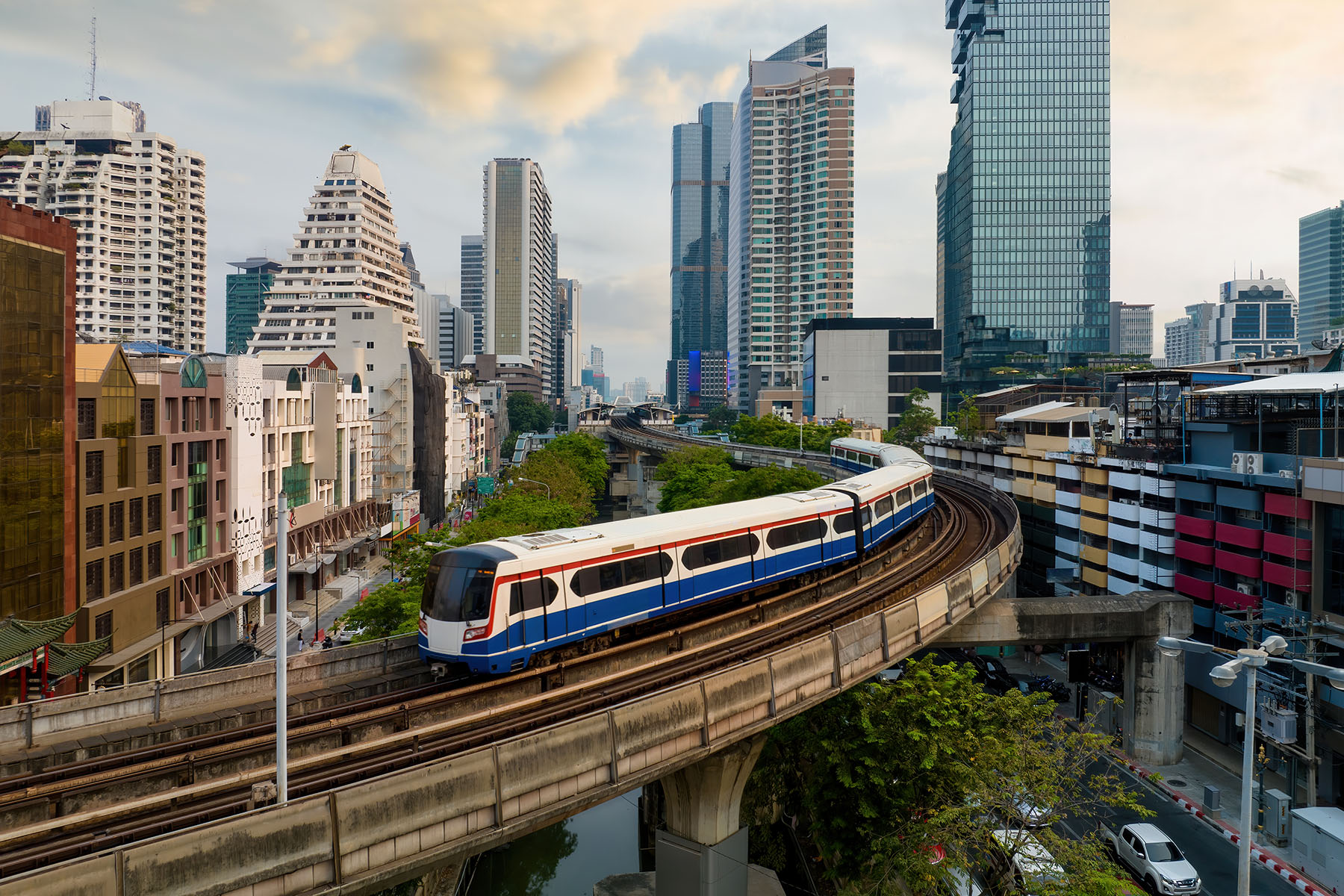
As the capital, Bangkok has Thailand’s most robust public transport system. Two urban rail systems – the BTS and MRT – and long-distance railways connect the city to other parts of the country. In addition, there is a wide network of bus routes that go to all corners of the capital. There are also bus routes in smaller towns across the country and a network of long-distance coaches.
Many locals get around with motorcycle taxis (มอเตอร์ไซค์รับจ้าง) – a great option if you are short of time – and can brave the daredevil maneuvering, including drivers talking on their phones while in motion. But, for a bit of novelty, you can always try tuk-tuks (ตุ๊กตุ๊ก) for short distances.
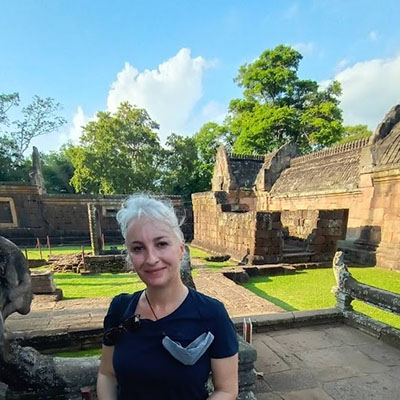
Local expert
Jane Evans
Insider tip
It is important to agree to a fare before setting off on a motorcycle taxi or a tuk-tuk. And, women passengers need good balance as they often sit sideways.
Public transportation apps and/or websites
Even foreigners who have been living in Thailand for a while may find it a challenge to navigate all transportation options. Routes and systems are complex – especially in Bangkok – making navigation apps like Google Maps and Apple Maps invaluable.

Writer and local expert
Gayatri Bhaumik
Insider tip
Language – and accent – barriers can complicate asking for directions. Words (even English ones) that sound exactly the same to a foreign ear, may have varying meanings when pronounced slightly different in Thai.
If you are based in Bangkok, there are a few local apps that might come in handy. These include:
- ViaBus: This is a popular app for figuring out Bangkok’s bus routes and those of other major cities. You will be able to see full bus routes and real-time locations.
- 12Go Asia: Great for long-haul transportation; you can use this app to quickly book intercity flights, buses, trains, and ferries within the country
- BTS Skytrain: The BTS Skytrain is Bangkok’s premier mode of public transport, and its official app is great for calculating routes, fares, and more
- Bangkok MRT: Another app for Thailand’s capital, this one is dedicated to the city’s subway system. You check journeys and fares and get suggestions for restaurants, bars, and places of interest near each station.
Are there trains that go through Thailand?
Thailand’s transportation network includes overground railways that connect different parts of the country. While you may not be able to get to every destination within Thailand by train (รถไฟ, rot fai), you can access large cities like Ayutthaya (อยุธยา), Chiang Mai (เชียงใหม่), Chiang Rai (เชียงราย), Pattaya (พัทยา), and Hua Hin (หัวหิน).

As in most other countries, Thai trains offer several classes of carriages:
- The first class is comfortable and usually features air conditioning and electric sockets. These private cabins can be quite expensive and need to be booked beforehand. On long-distance trains, the seats can transform into bunk beds.
- While less luxurious, the second class is usually more affordable and still reasonably comfortable. Seats are individual chairs, and there is usually an air-con or a ceiling fan. If you prefer sitting in an air-conditioned space, booking in advance during the high season is recommended. On some Special Express services, food and drink are included in the ticket price and served to you at your seat.
- The third class presents the cheapest option. These carriages have bench seats and feature small fans to cool passengers down. You can only buy a third-class ticket at the station on the day of travel, and carriages are typically full.
Trains tend to get fully booked quickly, especially during weekends, public holidays, and school holidays when many people travel. If you want to explore the country by rail, make sure to book tickets ahead of time.

Local expert
Jan Evans
Insider tip
If you plan to do a shorter journey in third class – such as Bangkok to Ayutthaya or Kanchanaburi – you can buy these at the station on the day. If you plan to travel, do it on a normal business day wherever possible, to avoid crowds, especially the Songkran holiday and New Year, when there is a mass exodus from Bangkok to other provinces.
Until very recently, Hualamphong in Bangkok was the country’s rail hub. As of January 2023, though, the brand new Krung Thep Aphiwat station – outside the city center – is the new terminus for most long-distance trains. That said, Hualamphong will still serve trains on routes such as those to Ayutthaya.
Train tickets and costs
It is technically possible to book tickets (ตั๋ว) on the website or by calling the official hotline. However, those in the know prefer to go through a reputable travel agent, such as 12Go Asia, or go on spec.
You can buy both single-journey (การเดินทางเที่ยวเดียว) and multiple-journey (เดินทางหลายครั้ง) tickets are any station through a ticket machine. You will need to pay in cash or coins as it doesn’t accept cards. Most stations also have a customer service desk where you can purchase tickets.
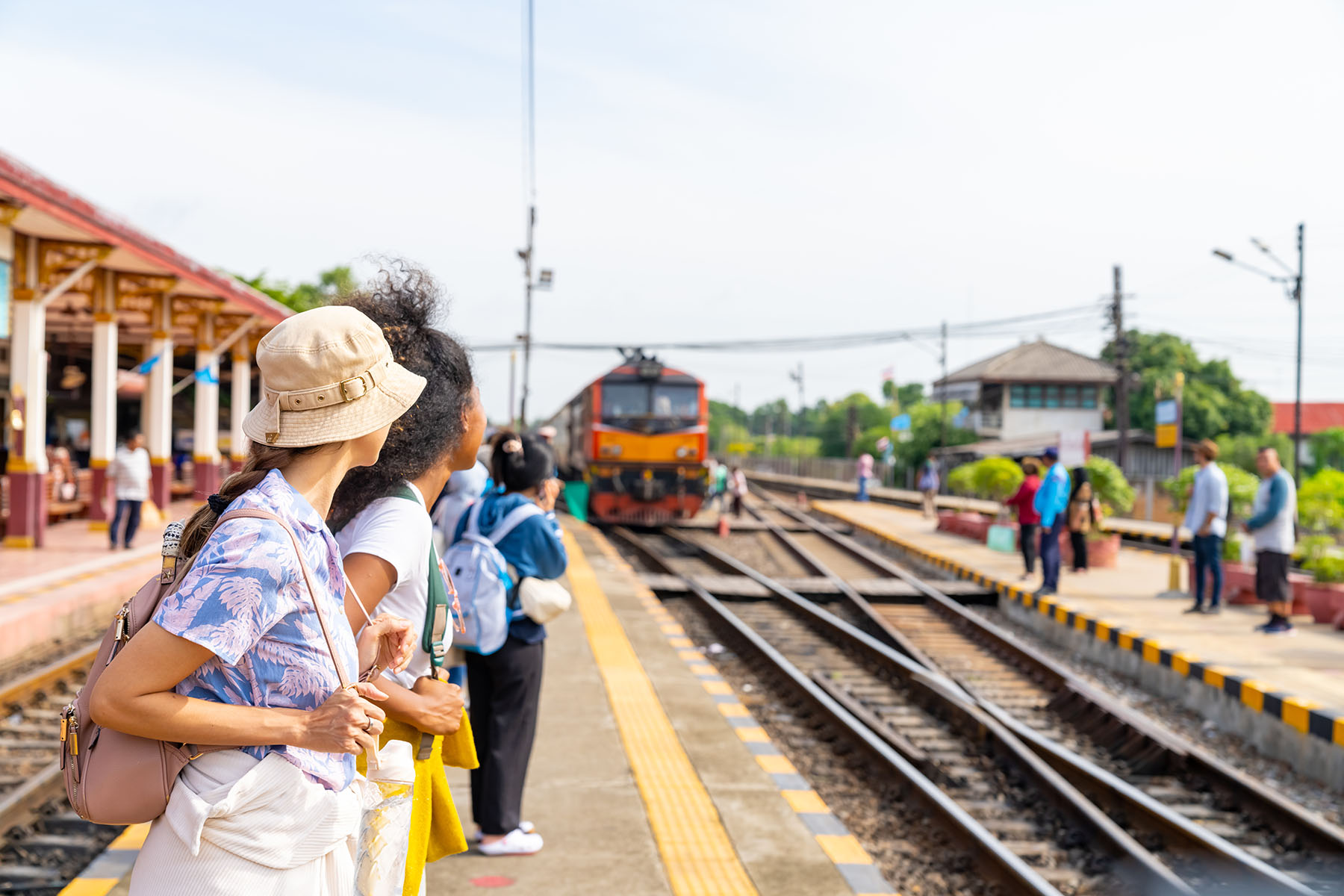

Local expert
Jane Evans
Insider tip
To ask for a one-way ticket, you can say bpai kaa deeyo (ไปขาเดียว). Dtua bpai glab (ตั๋วไปกลับ) means a return ticket.
Train maps and timetables
If you like old-school paper railway timetables, you can pick up a free booklet from the information counter at most stations. For more up-to-date schedules, you can also check the official State Railway Thailand (SRT) website or download the SRT app.
Train stations and stops
Thailand modeled the train system on those of other countries. As such, most stations are similar to what you would find in other large cities – albeit usually much bigger.
You’ll usually find several exits and entrances for each station, and each one will have stairs leading down to street level. Each station will usually also have one entrance with an elevator or escalator.
Most stations will have ticket machines, customer service desks, security points, and a variety of shops. Many also connect directly to major malls or locations – for example, Phrom Pong connects directly to the Emporium and EMQuartier malls.
Are there trains in Bangkok?
A popular way of getting around the sprawling metropolis is by train. There are two train systems in Bangkok: the Bangkok Mass Transit System (BTS) Skytrain and the Metropolitan Rapid Transit (MRT) Subway. The first is an elevated railway that exists entirely aboveground, while the second is, as the name suggests, entirely underground.
The BTS is useful for zipping across the heart of the capital without getting caught up in the city’s notoriously sluggish traffic. The vast network consists of three lines – the Sukhumvit Line, the Silom Line, and the Gold Line – and over 60 stations. It covers many areas that are popular with tourists and expats, including Sukhumvit, Silom, the Victory Monument, Siam, Nana, Asok, and the National Stadium. As such, more than 401,000 passengers use the system each day.

Local expert
Jane Evans
Insider tip
The BTS is handy for getting to and from Suvarnabhumi Airport (สนามบินสุวรรณภูมิ). The station at Phaya Thai links Central Bangkok directly with the airport and has a lift for passenger luggage. There are also other BTS stations from which you can access the airport link by changing lines.

Commonly known as rotfai dtaidin (รถไฟใต้ดิน, meaning underground train), the MRT subway (รถไฟฟ้า) consists of two lines – the Blue Line and the Purple Line – and 45 stations across the Greater Bangkok area. In June 2023, the MRT Yellow Line was launched for trial operation. More lines, including an Orange, Pink, and Brown Line, are planned for the future.
The MRT includes key stops like the airport, the Sukhumvit district, and the famous Chatuchak weekend market. More importantly, the network stretches into more suburban parts of Bangkok and, as such, is more often used by locals. Some stations become congested during rush hour and peak times, such as Siam Station, which joins the Sukhumvit and Silom lines.
Train tickets and costs
Tickets for the BTS and MRT are relatively inexpensive, especially in comparison to other major capital cities like London (UK), New York (US), and Tokyo (Japan). Fares start with a base rate and increase depending on the length of your journey. You can work out the exact cost of every trip using a ticket fare calculator, such as the one on the BTS website.
You can use the ticket machine or ask the service desk to buy a ticket. Most residents who use the trains regularly opt to buy the stored-value Rabbit card. This is available at stations through the customer service desk. Seniors aged over 60 and students aged under 23 are eligible for a discount.
Train timetables and maps
Bangkok’s trains run daily from approximately 06:00 until midnight and operate very frequently (usually every few minutes). Network maps are easily available at stations or online.
How to get around Thailand by bus?
Buses (รถเมล์) are a significant part of the transportation system in Thailand, especially in Bangkok, which has a sprawling network.
They are among the cheapest forms of transport and, as such, are very popular with locals. However, because it can be very difficult to figure out routes and stops, most expats never bother using buses.
Maps and timetables
Bus routes in Thailand can be a little confusing, and there are no paper timetables or maps. To pin down which routes to take where and at what time, it’s best to use an app like Google Maps or ViaBus. These often have live timings and routes.

Bus tickets and costs
Your fare will depend on the length of your journey and whether or not the bus is air-conditioned. You will need to pay this directly to the bus attendant. Simply tell them where you got on and where you are getting off, and they will tell you how much to pay – be sure to have cash or small change at hand.
Bus stations and stops
Many bus stops only have signposts or nothing at all, so you may have to look for where other people are queuing on the street. Often, buses whizz by stops if you do not hail them down like a cab.

Local expert
Jane Evans
Insider tip
When traveling on public transport, there is a risk of crime and road accidents, so stay alert. Large government company buses might be slower but they’re safer than minivans and private company buses. That’s because these are adequately maintained and adhere to speed limits. For women traveling by bus, there is an option to sit in a female-only area.
What buses can you take in Bangkok?
The state-run Bangkok Mass Transit Authority (BMTA – องค์การขนส่งมวลชนกรุงเทพฯ) operates all public buses in the city, under the purview of the Ministry of Transport. However, it has also teamed up with some private operators to operate certain routes.
There are many different types of buses in Bangkok, and you can figure out the different types by their color. Pay attention, and you can jump aboard one of the following buses:
- Air-conditioned bus (primarily blue)
- A private joint-venture bus
- A regular (mostly red with open windows)
- Express bus
Timetables and maps
In Bangkok, buses typically run between 05:00 and 22:00. There are also some night buses to get people home after a late shift (or a night out). You can look online for route information.
Taxis, UBERs, and other car services
Taxis are plentiful around Bangkok and other cities across Thailand. And, since most of them have air conditioning, they offer easy respite from the daily heat.

You’ll likely see taxis in a wide range of colors – this is merely an indication of the company. The cars and service are generally all the same. Be sure to avoid taxis that are parked at tourist spots; it’s best to hail a taxi that’s driving down the street.
Taxis usually have meters to calculate fares; in fact, it’s illegal not to use them. However, it is good practice to confirm it is working. In some instances, taxi drivers will ‘forget’ to switch on the meter and surprise you with an insanely high fare at the end of the trip.
Or, they will say the meter is not working and try to negotiate a fare with you. If you are confident, you can get to bargaining. Otherwise, you can politely decline and hail another taxi. Fares start at THB40 (USD$1) for the first kilometer and then increase based on the distance traveled.

Local expert
Jane Evans
Insider tip
If you wish to use a metered taxi, opt for the more reliable green and yellow cabs the drivers own instead of the rented pink-metered ones.
Ride-hailing services
You can also opt for a ride-hailing service such as Bolt or Grab. Grab is the main ride-hailing app in Thailand and offers a wide range of options for taxis, cars, and bikes throughout the major cities. You usually get a fare estimate, and you can also pay for your ride through the app.
Motorcycle taxis
You will need nerves of steel for this method of transportation: to avoid the heavy traffic jams that plague Bangkok, many locals jump on the back of a motorcycle to get around. These so-called motosais operate much like taxis and are useful if you need to get somewhere quickly. Fares depend on distance but tend to be cheaper than taxis.

Local expert
Jane Evans
Insider tip
When you take a motorcycle taxi, keep your knees tucked in as they zip between the traffic in a zig-zag fashion.
Long-distance bus services in Thailand
While there are long-haul bus services in Thailand, these are generally inadvisable. Drivers of overnight buses are notorious for driving under the influence, driving recklessly, or falling asleep at the wheel. Cases of highway robbery are also reported. In other words, it is best to avoid these.
However, if you’re up for an adventure, it is possible to take coaches from Bangkok to places like Chiang Mai and Phuket. Some buses even go as far as Siem Reap in Cambodia. There are several operators, including Bus Express, Greenbus Thailand, and Nakhonchaiair.
There are several bus terminals in Bangkok, including Mochit, Sai Tai Mai, and Ekkamai. All of these have ticket counters, cafes, toilets (ห้องน้ำ), and convenience stores. Most bus tickets will not be available online; if you’re looking to book in advance, it’s best to go through an online agency.
Which airports are there in Thailand?
There are 38 commercial service airports in Thailand, seven of which fly international. Airports (สนามบิน – meaning station fly) fall under the responsibility of the government Department of Airports (DOA – กรมท่าอากาศยาน) and are managed by their subsidiary Airports of Thailand (AOT).
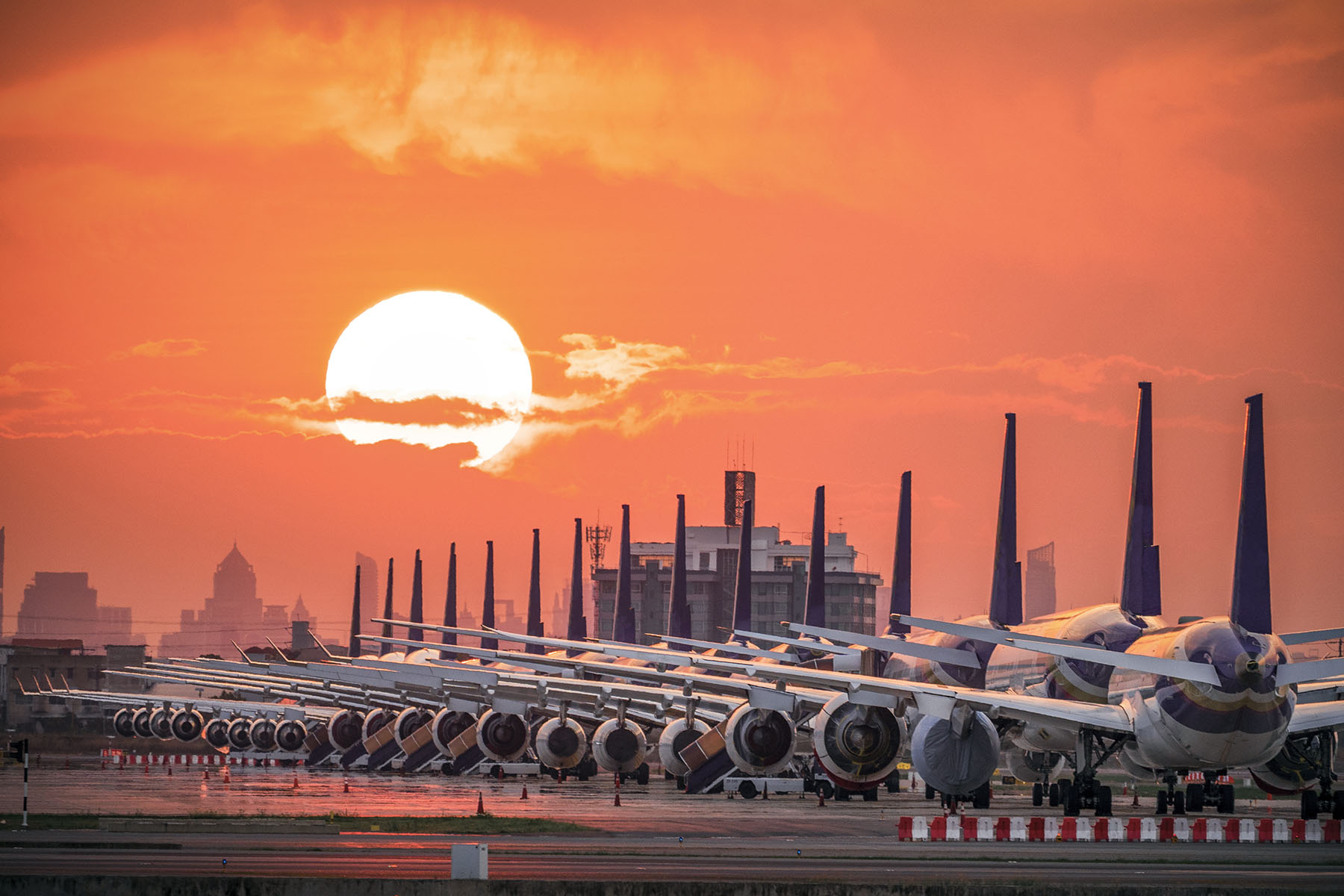
Suvarnabhumi Airport (BKK)
Also known as Bangkok International Airport, Suvarnabhumi Airport (สนามบินสุวรรณภูมิ) is Thailand’s main aviation hub, sitting mere kilometers from the capital.
It serves as the main hub for many Thai airlines, including Thai Airways, Thai Smile, Bangkok Airways, Thai Vietjet, and Thai Air Asia. Many international airlines also use this as a transit point, including Air China, Air France, Air India, Cathay Pacific, KLM, Lufthansa, Maldivian, and Singapore Airlines.
Each terminal here has a full range of stores, restaurants, lounges, and even massage parlors for pre-flight spa treatments.
Don Mueang International Airport (DMK)
Before the opening of Suvarnabhumi in 2006, Don Mueang International Airport was the country’s main airfield. It started in 1914 as a base for the Royal Thai Air Force and began taking commercial flights in 1924.
Now, the airport is Bangkok’s low-cost carrier hub and mainly has routes to domestic and smaller regional destinations from airlines such as Air Asia, Nok Air, Spring, and Thai Lion. That said, it is still a fully functional plane hub with all the facilities you would expect.
Phuket International Airport (HKT)
Serving the vacation island of Phuket, Phuket International Airport is the second busiest airport in Thailand. It has three terminals; one for domestic flights, one for international flights, and a third that exclusively caters to charter flights.
Airlines serving this airfield include Aeroflot (Phuket is notoriously popular with Russians), Bangkok Airways, Air China, El Al, Emirates, Etihad, HK Express, Jetstar, Singapore Airlines, and Vietjet.
Chiang Mai International Airport (CNX)
Sometimes called the gateway to the north, Chiang Mai International Airport is the entry point for cities like Chiang Mai and Chiang Rai. Smaller airlines such as Scoot, Air Asia, Bangkok Airways, EVA Air, and Korean Air serve this airport, bringing in a fleet of international – and domestic – tourists each year.
Samui International Airport (USM)
Samui International Airport puts visitors on island time as soon as they arrive. Travelers disembark from the aircraft straight onto the tarmac and are ferried to the single small terminal by a stylish little train. The whole airport features an open-air design, though the VIP lounge, shops, and toilets are inside the terminal. Bangkok Airways is the main airline flying in and out of this airport.
Other forms of public transport in Thailand
The most iconic method of transportation in Thailand is probably the tuk-tuk. These three-wheeler vehicles are a fun way to get around, though not entirely practical for anything more than the shortest of trips.
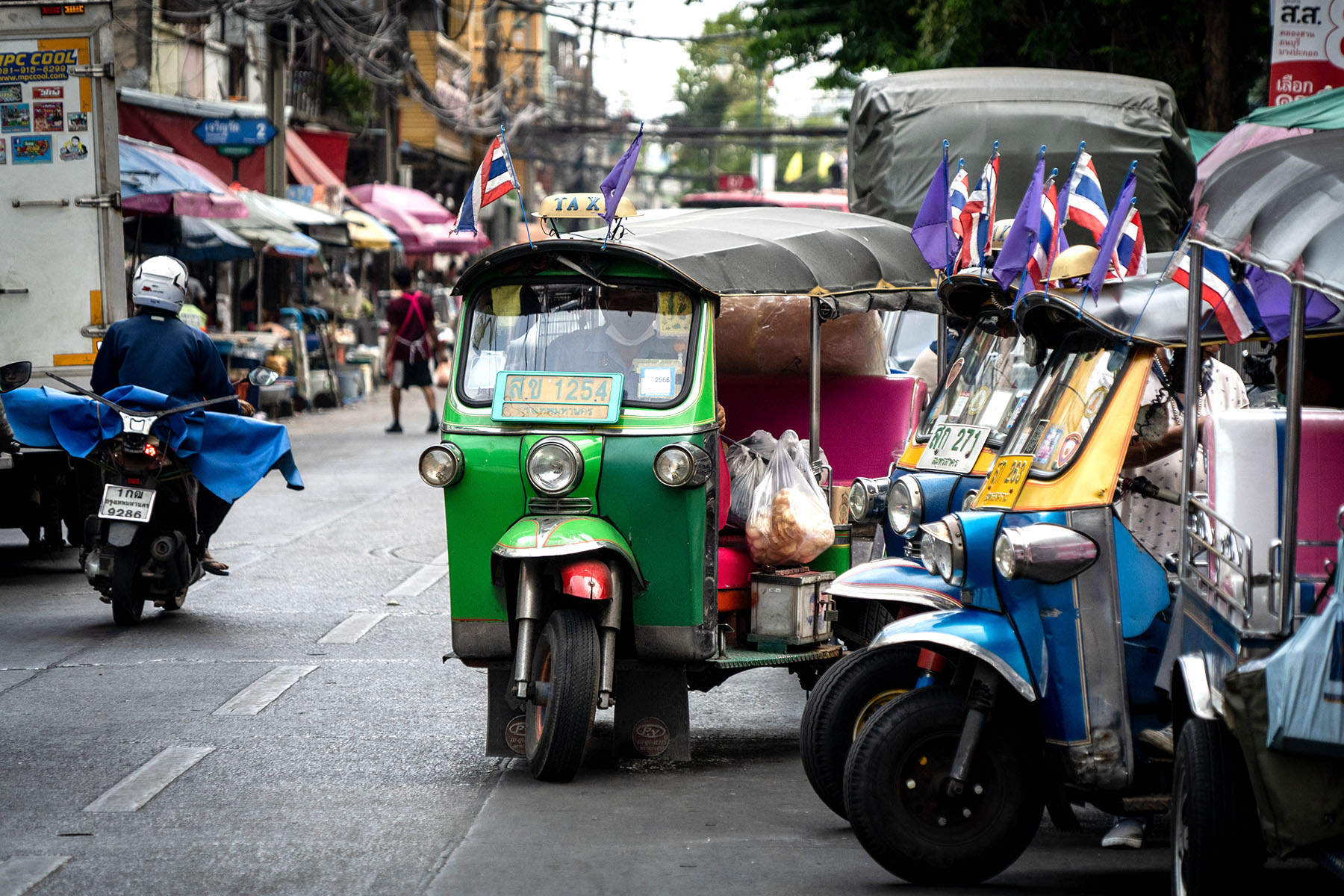
Tuk-tuks are more expensive than motorcycle taxis – probably because of the novelty factor – but you will need to use your bargaining skills and agree to a fixed fare before you hop aboard. Make sure you brush up on some useful Thai phrases beforehand.
If you’re looking for a local transport experience, be sure to hop aboard a songthaew (สองแถว), which translates as “two lines” because there are two benches in the back. They are hard to describe to the uninitiated, but essentially, these are modified pick-up trucks.
Songthaews are cheap and operate much like buses – simply pay the driver once you reach your stop. You might not find many Songthaews in Thailand’s big cities because they are more common in smaller towns.
Are there any discounts or financial aid?
The Rabbit Card (บัตรแรบบิท) – which is mainly for the BTS and MRT in Bangkok – offers special discounted options for seniors over 60 and students under 23. However, in general, because transport fares are so low, there are no other discounts on public transport.
Of course, for taxis, motorbikes, and tuk-tuks, it is entirely possible to get a discounted rate by bargaining before you take the ride.
Is Thai public transport disability-accessible?
Although some strides are being made to make Thailand’s transportation more accessible for people living with disabilities, there is still a long way to go. Public buses don’t have any features to make them accessible for wheelchair users. Similarly, only a handful of BTS stations have elevators. The vast majority only have stairs and escalators.
The MRT subway in Bangkok is slightly more accessible, with all stations having elevators and staff who can assist passengers with disabilities.
Is public transport environmentally friendly?
While, in theory, the Thai government is aiming to become more environmentally friendly through initiatives like the Climate Change Act, the reality is not quite there yet.
However, the BTS’s yellow line is a completely automatic monorail that uses smart technology to run. And Bangkok’s public buses aim to be fully electric by 2025.
Safety tips for transportation in Thailand
In general, public transportation is quite safe. However, you will want to stay aware of your surroundings as petty crime does happen.

Here are a few insider tips to keep you and your belongings safe:
- Always keep your belongings close; keep your backpack or handbag on your body (if possible)
- Ensure you know your route before taking any transport; track your route with Google Maps while underway
- Get a rough idea of prices before you take a (motorcycle) taxi or tuk-tuk; negotiate before you get on board
- When hailing a taxi in the street, insist on the driver turning the meter on as soon as you get in – if they refuse, decline the ride and get out. Always stay friendly, however. Losing face (การเสียหน้า) is a cultural faux pas in Thailand, and it is not uncommon for violence to occur when it does happen. Therefore, it is crucial not to engage in road rage; even flipping the bird can cause a situation to turn nasty very quickly.
- Try and book taxis or cars using Grab or Bolt instead of getting in a taxi from a stand or the street
- Avoid taking overnight buses – if you must, try and keep your bags with you and ensure you protect them with padlocks
How to file a complaint about public transport
Problems with Thailand’s transportation do occur. If you encounter an issue with the country’s public transport, you can file a complaint with the MOT. There are several ways to do this:
- Filling out an online form
- Calling 0221888 or 1584
- Emailing to [email protected]
